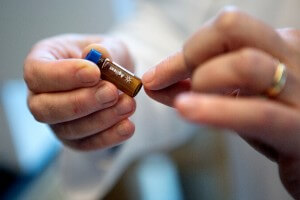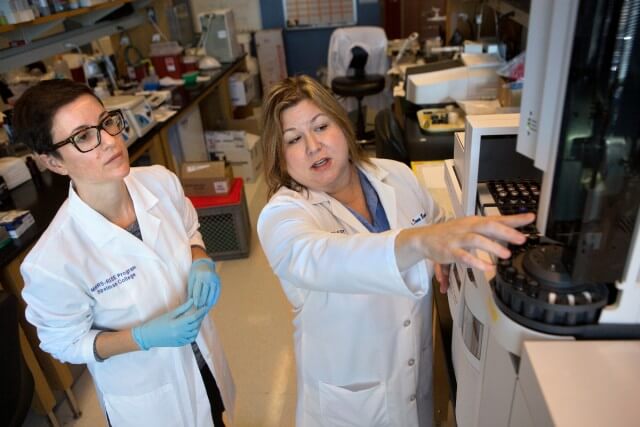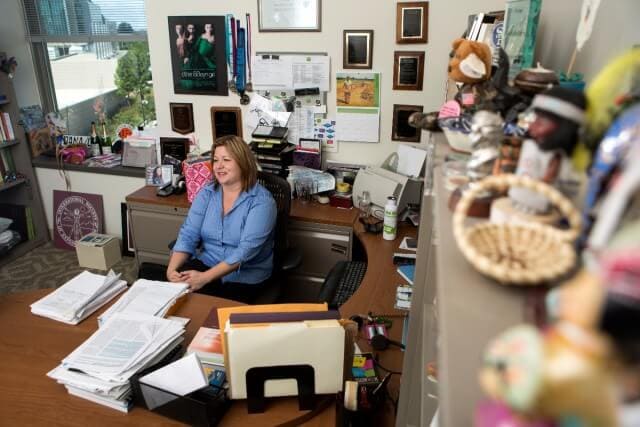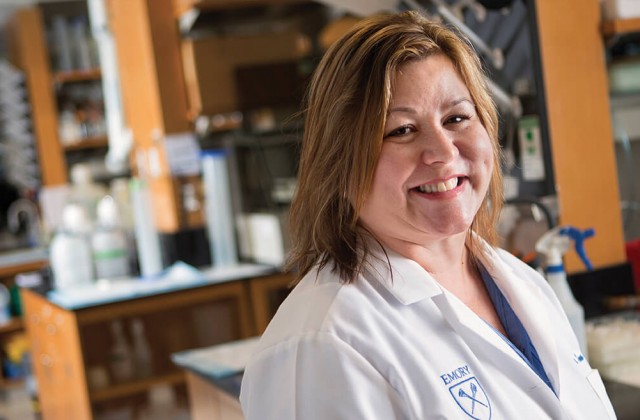The ‘Very’ Quotable Dr. Dana Barr
Reuters this year declared Dana Boyd Barr one of the most quoted environmental scientists in the world because of her expertise in global public health issues.
On a late afternoon at the end of August, the Emory University campus in Atlanta has that new-school-year buzz of excitement. Shiny blue and gold balloons deck the main staircase of the Rollins School of Public Health building. Students and staff chat in the hallways. For Dana Boyd Barr, Ph.D., a professor of environmental health, this semester looks a little different from most years: Now she’s one of the students.
Barr has started work for her Master of Public Health (MPH) degree, taking classes alongside some of the same students that she teaches.
“The school did let me exempt out of my own class, though,” she says. “Which is a shame, because I’m pretty sure I would have gotten an A.”
For a woman who’s won some of environmental health’s top accolades, you wouldn’t know it by glancing around her office. The walls are lined with plaques honoring Barr as a mentor, a teacher, a cheerleading coach. She taps at her keyboard surrounded by photos of her three beaming children.
Through her window looms the mammoth outline of Emory’s neighbor, the headquarters of the Centers for Disease Control and Prevention. Barr spent 23 years there, starting in entry-level lab work to become chief of the pesticide laboratory and one of the foremost environmental health experts in the world. In 2014, Thomson Reuters named her one of the most highly cited researchers on the environment. She’s been honored for her leadership, her technical skills in the lab and her game-changing scientific findings, which have helped scientists better understand how the chemicals humans use in the environment impact our health.
In 2010, she moved literally across the street to join the faculty at Emory. It was hard to leave the CDC, where she’d spent her entire professional life. She even met her husband, John, in front of a Xerox machine there.
“I’d had a great career there. They really allowed me to develop my own niche in my field,” Barr says. “But my work at CDC had gone about as far as it could go. It was time for a change.”
At Emory, she spends more of her time teaching, mentoring and helping public health graduate students find their own passions for environmental health. But she’s still dedicated to one thing: finding newer, better ways to protect people from harmful chemicals.
Chemicals and Consequences
Barr’s field is exposure science, the study of the interactions between chemicals in the environment and human health. She’s spent most of her career looking into how people are exposed to chemicals and how those chemicals affect their bodies, including determining the amount it takes to cause damage, whether quickly or over many years.

In her research, she looks for biomarkers, telltale signs in a body’s cells that can show scientists a path between a chemical in the environment and a health outcome. Her work has helped many scientists better understand how they can use biomarkers to measure the impact of chemicals.
“She literally brought these subjects to light,” said Parinya Panuwet, Ph.D., an assistant research professor at Emory. He first talked with Barr when he was a researcher in Thailand, trying to reproduce one of the analytical methods she developed. When he reached out to her for help, she invited him to study the technique with her and her team at CDC.
“She has provided a gateway for scientists around the world,” he said.
As far as Barr is concerned, what’s the point of doing research if it can’t be put to work on a wider scale?
“I don’t like for us to do science just for the sake of doing scientific research. I like research to be applicable to something,” she says.
In many cases, her work has saved lives. At CDC, Barr was a leader in nearly half a dozen responses to public health emergencies around the world when people were poisoned by chemicals. In 1996, she was part of a team called to Haiti when 86 children were poisoned by cough syrup contaminated with diethylene glycol, a chemical cousin of antifreeze. Throughout the 1990s, she led lab work testing people whose homes had been sprayed with illegal methyl parathion – “cotton poison” – in eight U.S. states.
Barr won the U.S. Health and Human Services (HHS) Secretary Award for Distinguished Service two years in a row for her role in these responses. But the reward was bittersweet.
We are getting at the very basic biological mechanisms that affect someone’s health.” – Dr. Dana Barr
“That kind of thing just shouldn’t happen today. And we know it happens continually,” she says.
For many people, exposure to chemicals doesn’t come in single, life-threatening doses. It happens gradually, and many of us don’t give it much thought. Barr and other researchers in exposure science try to understand what the chemicals in everyday life mean for human health.
Barr’s specialty is the study of organophosphate pesticides, used by farmers all over the world to protect their crops and sometimes to kill bugs in homes. But they’re also some of the most harmful for humans. Nearly 30 studies have linked these chemicals to autism, ADHD, low IQ levels and brain changes that impact behavior and attention.
Right now, Barr is studying how these chemicals affect children in the U.S. and those born to women who work on farms in rural Thailand. She calls this some of her most important work, hoping it will emphasize the importance of safety, regulation and rigorous industry standards.
“I don’t believe every chemical is harmful,” she says. “But we need to know how to use and test them, and we need to do this prior to introducing them on such a wide scale.”
The study of chemicals like these could also offer new clues about some of the world’s colossal health problems, like cancer, diabetes and obesity.
That’s the mission of a new initiative at Emory. In the fall of 2013, the university and Georgia Tech received $4 million from the National Institutes of Health to launch the U.S.’s first study of the exposome, the totality of all the environmental exposures humans face – everything from air pollution to lead to radiation. The project is called HERCULES – Health and Exposome Research Center: Understanding Lifetime Exposures.
Barr is one of the core directors for the project, in charge of giving researchers tools to assess different chemical exposures. She’s also conducting her own studies, including expanding her work with Thai mothers and investigating pesticides in baby food.
“We’re getting at the very basic biological mechanisms that impact someone’s health,” Barr says. “It’s a big challenge, but it’s very exciting that we are at the forefront of it.”
Beginnings at Brenau
Barr has occupied places at the forefront since her early days at Brenau. In 1983, then 18-year-old Dana Boyd came to Brenau on a scholarship, the first member of her family to go to college. She started her freshman year aiming for a degree in nursing. But in her first year of basic coursework, it became clear that she was a brilliant science student.
“I didn’t have a good chemistry teacher in high school. But I had great chemistry teachers at Brenau. They were so passionate and enthusiastic. They made you understand it and be excited to do it. That’s when I knew I really wanted to study chemistry,” she recalls.

At the time, the school didn’t offer a chemistry major, so Barr graduated with a degree in biology. (In 1994, she earned her doctorate in analytical chemistry from Georgia State University.) Within two months, she got a job in the CDC’s malaria division. Half of her job was to feed the mosquitos. (They eat ground-up dog food, in case you were wondering.) The other half was to force-mate them, a task that involved anesthetizing the female and decapitating the male – “always a very good conversation piece,” she jokes.
The job was pretty much the lowest possible rung on the CDC ladder.
“But I felt like if I could get my foot in the door, I could go places,” she says.
Three months later, she got a job a few doors down from the malaria lab in the National Center for Environmental Health. The work fascinated her, but she found its importance was often overlooked in favor of infectious diseases or chronic conditions like cancer or heart disease.
“At that time, people weren’t really thinking about the underlying environmental causes of health problems,” she says.
Then, in the 1990s and early 2000s, as scientists were putting together the pieces of the human genome, they began to realize that only a small percentage of human disease could be directly linked to genetic causes. The rest came from the environment and the way humans interacted with it.
“That’s when it dawned on me that this is really important to study,” Barr says. “It’s about knowing how to leave the world a better place for my children.”
Family First
On her Twitter profile, Barr describes herself this way: “Mother of three (Aaron, John and Katie), wife to John, professor, scientist, cheer coach, daughter, sister, aunt, volunteer.” In life, too, family comes first.
Outside the lab, Barr has served as the team mom for all of her children’s sports over the years. Every Friday evening, she and her daughter volunteer as coaches for the Phenomenal Falcons, a cheer squad for girls with special needs. Being supportive of her children was always a priority for her and her husband, Barr says, but so is teaching them the value of serving others.

“I want them to know the importance of volunteering and giving back to people,” she says.
Her family also inspires her to do all she can to change things for the better.
“I want my kids to be proud, to know that they can achieve all that they want, have a family and a career,” she says. “But most of all, I want them to know that they can make a difference.”


Dana: What a thrill to read this article about you when my Brenau Window magazine arrived in the mail today. Sure wish I could work side by side with you. Kudos to all you do and congratulations!